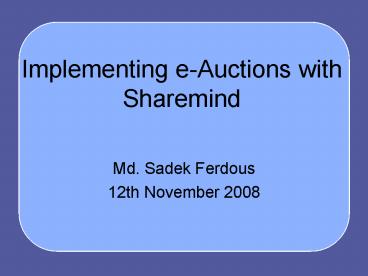Implementing eAuctions with Sharemind - PowerPoint PPT Presentation
1 / 22
Title:
Implementing eAuctions with Sharemind
Description:
One of the main forms of selling, buying and exchanging goods ... Discriminative auction, Non-discriminative --Combinatorial and Walrasian Auction ... – PowerPoint PPT presentation
Number of Views:69
Avg rating:3.0/5.0
Title: Implementing eAuctions with Sharemind
1
Implementing e-Auctions with Sharemind
- Md. Sadek Ferdous
- 12th November 2008
2
Overview
Types of Auction Possible exploitations in Auction
Advantages of e-Auction Auction steps Security
considerations Design Issues
Sharemind Proposed solution Design issues in the
solution Suggestion
Conclusions
3
Auction
- Mention of auction in as early as 500 B.C
- One of the main forms of selling, buying and
exchanging goods - Objective is the efficient trading of commodities
4
Types of auctions
- Open cry auction
- --English and Dutch auction
- Sealed bid auction
- --Sealed bid first price auction and Vickrey
auction - Multi item auction
- --Discriminative auction, Non-discriminative
- --Combinatorial and Walrasian Auction
- All pay auction
- Buyout auction
- --Permanent Temporary
- No reserve (NR) auction
- Reserve auction
- Reverse auction
- Round robin auction
5
Exploitations in auctions
- Bid shielding
- Collusion
- Bid schilling
- Bid sniping
- Bid siphoning
- Mispresented or non-existent item
6
e-Auction
- Shorthand for Electronic auction
- One of the major sources of revenue for
e-Commerce - eBay with yearly revenue of 7.67 Billion USD is
the main actor to popularize the term e-Auction
7
Advantages
- No time constraint
- No geographical constraint
- Potentially large number of sellers and buyers
8
Challenges
- Mode of payment
- Fraudulancy
- Posting
- Dependable Security
- Guarding against problems of traditional auctions
9
Auction steps
- Initialization
- Registration
- Bidding
- Winner determination
10
Security considerations
- Unforgeability
- Non-repudiation
- Anonymity
- Public verfiability
- Robustness
- Efficiency
- Fairness
11
Design Issues
- Trust issues
- Anonymity issues
- Bid authentication issue
12
Sharemind
- A framework for secure computation based on
- secret sharing.
- In secret sharing, a secret value is divided
among - several values known as shares
- Origianal secret can be reconstructed only if all
- the shares are known.
- In Sharemind, there are miner nodes and
- controller node.
- Controller divides the secret into share and
sends - them to the miners, miners perform operations on
- those shared values.
- Currently add or multiply two shared values,
multiply a shared - value by a constant, extract bits from shared
value, determine if - the two shared values are equal and if not,
which one is greater.
13
Proposed solution
- Sharemind with Group Signature Scheme
- Auction type Sealed bid
14
List of parties
- Auctioneer
- Bidder
- Registrar
- Miners
- Controller
15
Auction Steps
Initialization
- Auctioneer sets up an auction and advertises it
to the public. - Registrar sets up the group certificate.
16
Auction Steps
Registration
- Bidder creates a pair of
- public and private key.
- Sends a message to the
- auctioneer.
- Auctioneer provides a
- token.
- Bidder sends this token
- and his public key to the
- registrar.
- Registrar issues a group
- certificate and identifier
- for him.
17
Auction Steps
- Bid is sent to the controller.
- Controller signs them using
- private key, and then divides
- into three share, signs them
- again using group certificate
- and sends them to the miners.
Bidding
- The signature with private
- key adds veriability group
- signature adds anonymity.
- Miners verify the bid using
- group public key and stores
- them in their local databases.
- When bid ends, the miners
- determine the highest bid
- send that bid and the signature
- to the auctioneer.
18
Auction Steps
- The auctioneer publishes the
- winning bid.
- The winning bidder contacts
- with his identifier and signature
Winner determination
- The auctioneer contacts the
- registrar to get back the public
- key and the token associated
- with that id and receives them.
- The auctioneer comapres the
- two signatures, if it matches,
- the winners id is published.
- If more than one winner found,
- a second phase of auction may
- take place.
19
Design issues of the architecture
- Trust issues
- Anonymity issue
- Bid authentication issue
20
Enhancements of Sharemind
- Multiple controllers
- Simultanenous connections
- Hybrid database
21
Conclusions
- This talk has
- described various types of auction and different
exploitation methods in auction, - provided an overview on advantages, security
considerations and design issues in e-Auction, - presented a novel approach on how to integrate
Sharemind for e-Auction using group signature
scheme, and - suggested a few enhancements based on the
proposal.
22
Thank you. Questions or comments?































